March 2023 Newsletter: Rezoning for Housing Edition
- Back
- March 21, 2024

Hello Ward 6!
On April 22, 2024, City Council will consider rezoning for housing: the proposal to re-designate residential areas in Calgary (that currently allows only single or semi-detached homes) to also allow row houses and townhouses. If blanket rezoning is approved, such projects would no longer require an individual public hearing in front of Council.
Blanket rezoning was one of the recommendations of Home is Here: The City of Calgary's Housing Strategy 2024-2030 that City Council approved in September 2023 to address the ongoing housing affordability crisis. As we have seen in other large cities with housing prices increasing exponentially, Council decided to support this strategy to combat continuing surging housing prices and meet demand. Adding more variety of product to the housing inventory will decrease and/or halt increase costs of housing that Calgary is facing.
No final decisions have been made. I have personally read emails and spoken to constituents through events and phone calls regarding their questions and concerns. I will also be holding a Rezoning for Housing town hall on April 3 (details under “Events” in the newsletter) to listen to residents. Until the public hearing is completed, provincial law requires that all members of Council remain open to persuasion from the public on this matter.
COUNCIL UPDATES
___________________________
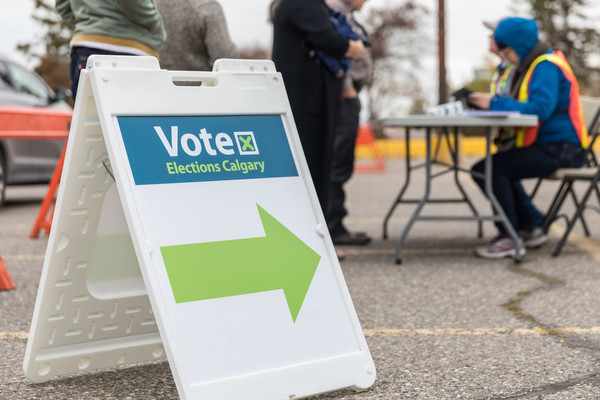
I did not support the Notice of Motion: Plebiscite on City Wide Blanket Re-Zoning as I had already made a commitment to Calgarians in September 2023 with the approval of Home is Here: The City of Calgary’s Housing Strategy, that I would listen to their voices in the Public Hearing which is scheduled to be held on April 22. The rezoning for housing is a bylaw change, and as per the Municipal Government Act, Council must hold a Public Hearing, regardless of whether a plebiscite is held or not. A plebiscite involves asking only Canadian citizens over the age of 18 for their views on an issue, rather than on the specific wording of proposed legislation or a constitutional amendment. Such votes can give a governing body direction on forming policy. Please remember this - a plebiscite is non-binding. The decision would still remain in the hands of Council, who must remain neutral and amendable to persuasion when holding a Public Hearing after the plebiscite.
Cost was also another factor in my decision in not supporting the plebiscite. In the Special Meeting of Council, we were advised that Administration has already spent $950,000 in engagement for the “Rezoning for Housing” Public Hearing. The plebiscite would have cost us another $50,000 if done in conjunction with the election, and then we would have to spend another almost million dollars to re-engage Calgarians for another Public Hearing. In my view that is irresponsible spending.
All Calgarians can submit their comments for Public Hearing on April 22 and I unreservedly encourage people to do so. This meeting will be a wholesome discussion where Council can truly hear and appreciate the concerns of the citizens. Whether you submit a letter for the public record or sign up to either virtually or in-person speak for 5 minutes, we will hear from anyone who would like to share their concerns and opinions. I look forward to hearing from everyone and making an informed decision based on what I hear. I campaigned on “We can’t thrive unless the rest of the City thrives”. As I go into Public Hearing that is what is upmost on my mind - making a Calgary where everyone thrives.
In order to provide you with as much assistance as we can, here is some basic information on public submissions and speaking panels.
Public Submissions - Due no later than 12:00 p.m. on 2024 April 15
- Written submissions from the public must be received by the City Clerk’s Office no later than 12:00 p.m. on 2024 April 15 in order for them to be included in the Agenda.
- Public submissions should be submitted to Council via the City Clerk’s Office Public Submissions portal: Public Submission to City Clerk's Office (calgary.ca). The Public Submissions portal includes important information for the public with respect to:
- Freedom of Information and Protection of Privacy Act (“FOIP” Act), and
- Endorsement statement on Truth & Reconciliation, Anti-Racism, Equity, Diversity, Inclusion and Belonging.
- Public submissions must be in a form which can be reproduced in the written record of the Public Hearing Meeting of Council.
- Public hearing submissions and other communications from members of the public must:
(a) clearly set out the matter at issue or the request;
(b) use respectful language; and
(c) contain the requestor’s name and a method of contact.
- The name of the public member making a submission to Council, and their comments, will be made publicly available in the Public Hearing Meeting of Council Agenda and Minutes.
- A public submission or communication received by the City Clerk’s Office which does not meet the conditions set out in the Procedure Bylaw may be withheld and the requestor notified if notification is possible.
- No written public submissions will be accepted by the City Clerk’s Office from the public after the advertised submission deadline, and nor will late public submissions be provided to Council by the City Clerk’s Office; however,
- a written submission from an individual or group who make a verbal presentation to Council at the 2024 April 22 Public Hearing Meeting of Council may be accepted into the Corporate Record with the permission of the Chair; or
- an individual or group may contact a Member of Council to make a motion at the 2024 April 22 Public Hearing Meeting of Council to add public submission(s) to the Corporate Record.
- Additional information on how to Participate in public hearings of Council and committee (calgary.ca) is available on www.calgary.ca
Panels
To facilitate the efficiency of a Public Hearing, the Procedure Bylaw 35M2017 [sec. 86(5)] provides that the Chair, in consultation with the City Clerk, may direct that multiple speakers make their submissions in a single panel.
Each speaker in the panel will be permitted to speak for five minutes, and Council will not ask questions until the entire panel has made their submissions, at which time each Member of Council will have five minutes to ask questions of any individual in the panel.
DID YOU KNOW?
_______________________
Over the last few months the Ward 6 office has heard from constituents with their questions on rezoning for housing. We have compiled some common FAQ’s:
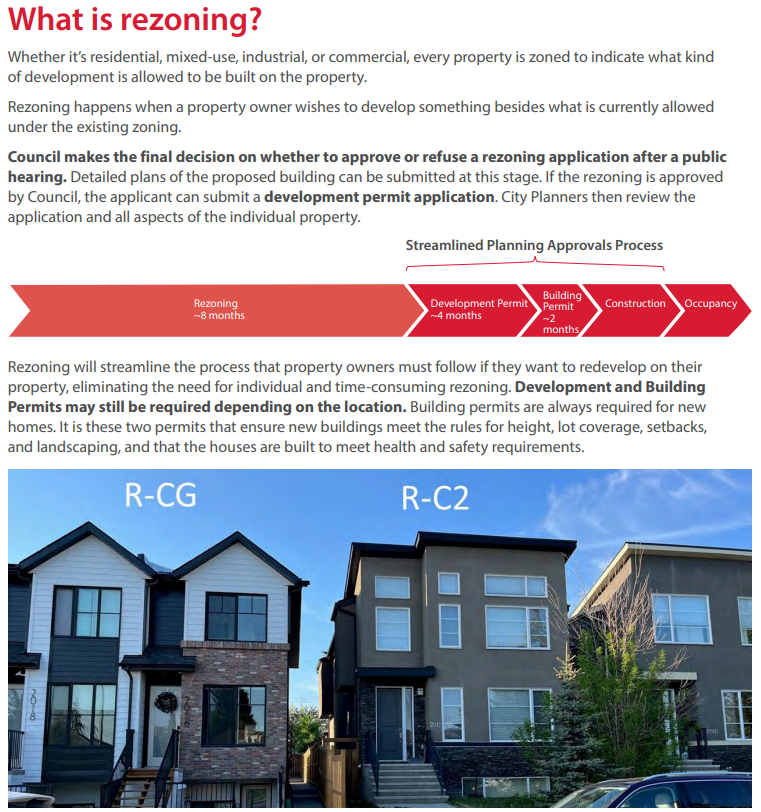
Q: What does rezoning mean if Council approves the proposed initiative:
- It will be easier, and legal, to build various types of homes in our communities. This includes single-detached, semi-detached, row houses, and townhouses.
- Properties that currently only allow single or semi-detached homes will be rezoned to R-CG, R-G or H-GO.
- Proposed (re)developments will still need to go through the development permit and approval process. This is where all aspects of the development will be reviewed in detail.
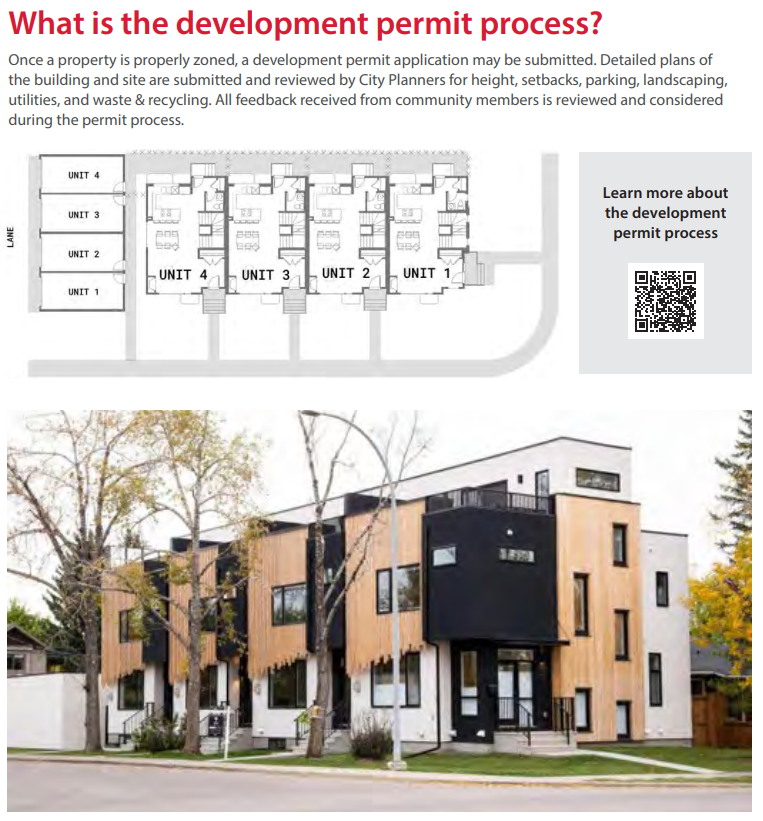
Q: What are the misconceptions of rezoning?
- Property owners will be prevented from replacing existing homes with new, single-detached homes. Existing single-detached homes will also not be removed.
- Removing single-family homes or only supporting row house developments. Rezoning will increase housing options. It intends to meet the demand from Calgarians for homes with front doors at ground level (not apartments).
- Removing the development permit process. The landowner will need to apply for (re)development and building permits. This is to ensure the proposed new home(s) remain compatible with the surrounding community.
- That apartment buildings can be built on parcels where single-detached homes are today.
- The proposed rezoning to R-CG, R-G, and H-GO will include existing parks or green spaces. While parks are being proposed for rezoning (i.e. shifting from R-C1 to R-CG), this does not mean they are being proposed for development. They will remain park spaces even if they are rezoned.
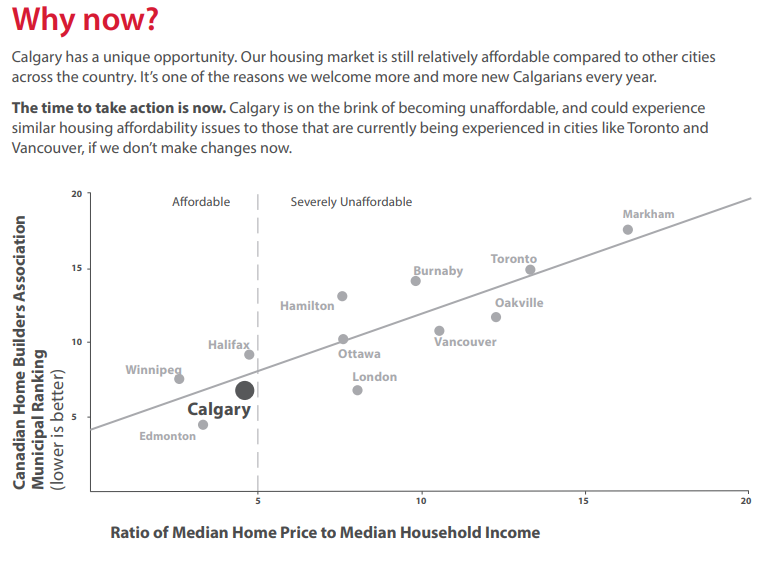
Q: Why does rezoning for housing matter?
As with other goods, the balance between housing supply and demand influences price and availability. Research evidence is clear: a variety of abundant housing is fundamental to affordability. Rowhouses, for example, give Calgarians a type of home that is in high demand at lower price points compared to single and semi-detached houses in the same community. It improves relative affordability compared to if they are not widely available.
Q: The approved Housing Strategy recommends proactively rezoning land parcels in Calgary that don’t currently allow for more than one or two houses. What does that mean?
By rezoning all residential parcels that currently only allow for 1 or 2 units, it will be easier for property owners to add additional housing varieties across the city, without having to go through the additional steps of a Land Use change Amendment application. Property owners will still be required to apply for a development permit to ensure proposed new houses are compatible with the surrounding community and all rules in the Land Use Bylaw are followed. Administration will bring forward a rezoning proposal for Council’s consideration and decision by no later than Q2 2024.
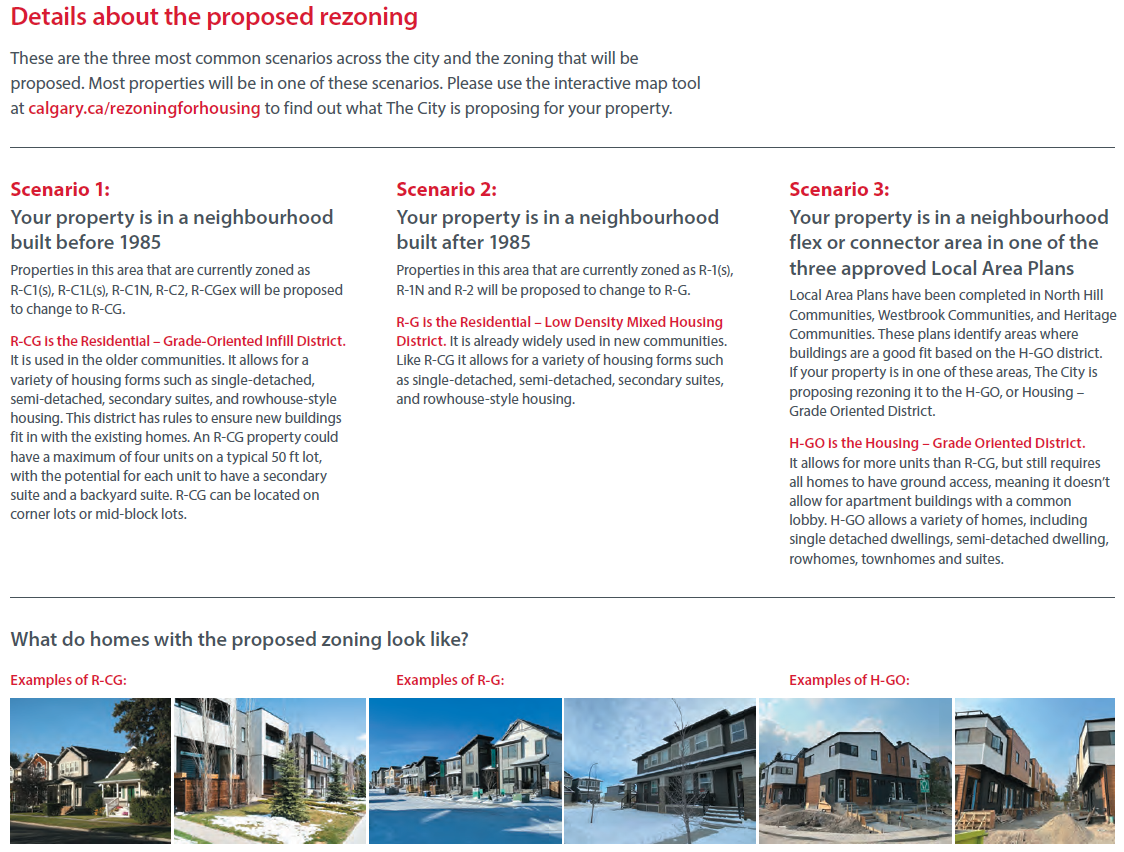
Q: What is R-CG and R-G and how do they differ?
R-CG stands for Residential – Grade-Oriented Infill District. R-G stands for Residential – Low Density Mixed Housing District. These are two modern districts in the Land Use Bylaw that both allow for a range of low-density homes, including single-detached, semi-detached and rowhouses. The primary difference between them is that the R-CG district is used in the established communities and contains contextual rules (the “C” in R-CG) to ensure infill buildings fit into the context of the existing homes on the street. Since R-G is used in new, developing communities that are designed by the developer, context rules are not needed.
Q: Which parcels of land will be affected now that Council has directed Administration to propose changes to base land use district to R-CG?
All parcels that are zoned R-C1, R-C1L, R-C1Ls, R-C1s, R-C1N, R-CG(ex)& R-C2, will be proposed for rezoning to R-CG. Parcels currently zoned R-1, R-1s, R-1N and R-2 will be proposed for rezoning to R-G.
Q: Will rezoning forbid construction of single-detached homes?
No. At the time of development or redevelopment a landowner will decide what type of housing they would like to build. The proposed development would have to comply with all the rules of the Land Use Bylaw. This change will not take away the ability to build single-detached dwellings, the change is intended to provide more housing options for landowners. The landowner decides what type of home they want. The City will also not demolish existing single-detached houses. Further, because the rules of R-CG and R-G have been amended over time, they provide the best rules to develop all forms, including single-detached homes.
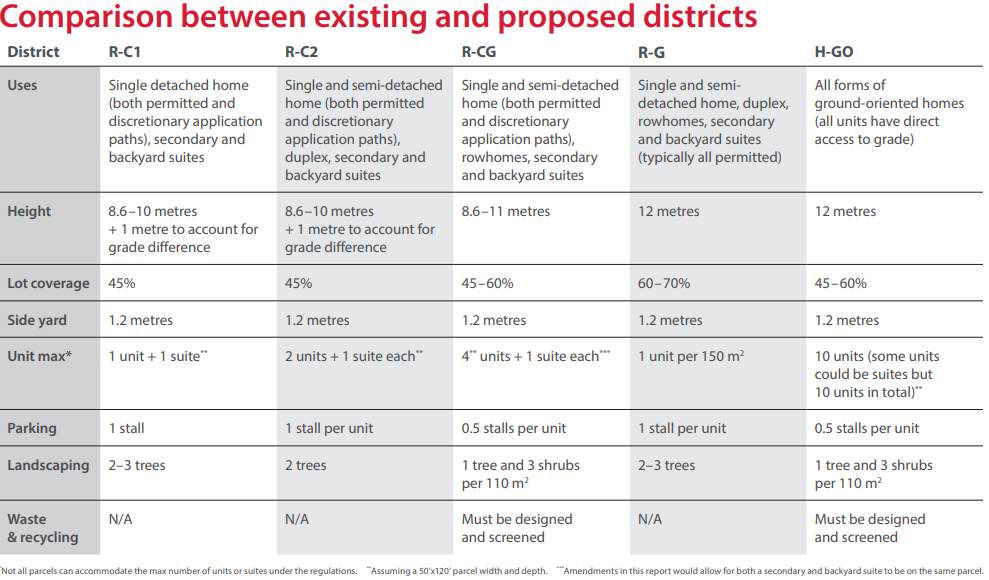
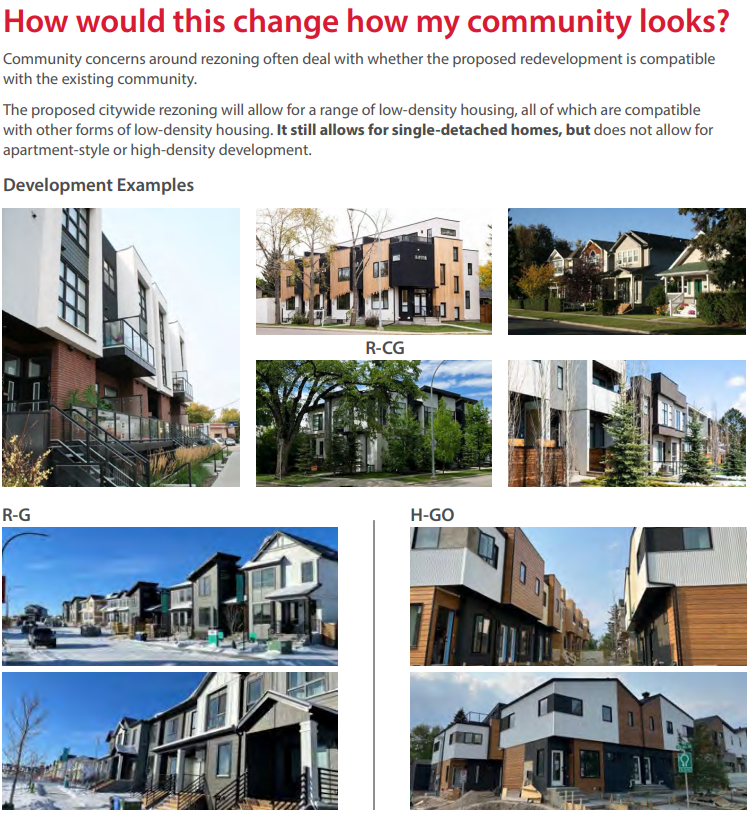
Q: Where will redevelopment happen? In every community?
Not all communities will experience R-CG or R-G redevelopment, with many newer communities unlikely to experience any redevelopment of this type within the next 15-20 years. There are several factors that affect the likelihood of redevelopment to occur, including:
- Land value, age, and condition of an existing home
- Location
- Lot shape
- Lane access
With the introduction of the R-G district in the developing areas in 2016 (R-G is very similar to R-CG except for contextual rules), the majority of our applications in developing areas are using the R-G district. This district provides more flexibility to developers to adjust their development forms based on current market trends without having to rezone. There is still a significant amount of single detached homes being built under R-G. The application of R-CG in the developed areas will likely have the same effect, allowing developers to create a range of housing types that are responsive to the market. You can check the proposed zoning for your house in this interactive map.
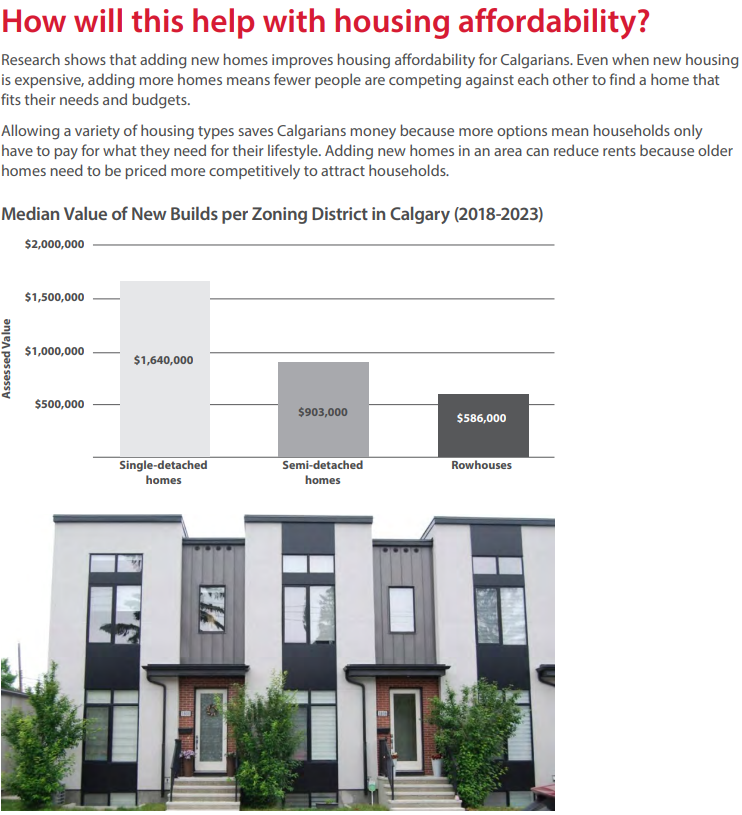
Q: What is the relationship between new housing supply and broader housing affordability? In addition, these new homes are expensive, how can they do anything to help housing affordability?
Research shows that adding new homes improves housing affordability for Calgarians. Even when new housing is expensive, adding more homes means fewer people are competing against each other to find a home that fits their needs and budgets.
Allowing a variety of housing types saves Calgarians money because more options mean households only have to pay for what they need for their lifestyle. Adding new homes in an area can reduce rents nearby because older homes need to be priced more competitively to attract households.
Q: If someone builds a rowhouse, what is the impact on property value of the single-detached house adjacent to or directly across from the development?
Based on current market analysis, there is no evidence that there is any negative impact on the property value of houses adjacent to rowhouse developments.
Q: Is there an impact to assessment values if rezoning moves forward?
City tax assessment values are based on the market value for the building/type of building based on market comparables. While the latter may reflect redevelopment potential, the redevelopment potential is not factored into The City's tax assessment.
Q: Can my neighbourhood manage the additional parking required for increased congestion as a result of growth and redevelopment?
Yes. On-street parking is for everyone. Where parking congestion is an issue on streets, we take steps to ensure that there is enough parking available by managing the space with permit parking, time restricted parking, or paid parking. We also work with builders to make it easier to use different modes of transportation for future residents, such as providing bicycle parking and building better sidewalks, among other things.
Q: Was the decision to change the zoning and make the base residental district R-CG influenced by the Federal government/programming/funding?
Cities across Canada and the USA are facing a housing crisis, largely because of high demand and low supply. City zoning bylaws that prohibit homes that are smaller and more affordable are one of the key constraints on the supply side of the market. Many cities across North America are changing their zoning bylaws to allow for more choice of housing, regardless of any federal funding.
The proposed rezoning was included in “Home is Here, The City of Calgary’s Housing Strategy 2024-2030” before a decision from the Federal government was communicated to the City of Calgary regarding the Housing Accelerator Fund (HAF), and prior to the agreement being signed.
Council will make the decision to proceed or not proceed with the rezoning at a Public Hearing of Council on April 22, 2024. If City Council does not approve the proposed rezoning, the fourth advance of HAF Funding may be impacted. Federal Housing Minister Fraser’s letter in September to Mayor Gondek and members of City Council, did, however, highlight the importance of taking this action to help create more supply.
Q: Did the City engage the real estate industry in creating the proposal to rezone low density districts to R-CG, R-G or H-GO? If so, who was included?
The City Of Calgary is in continuous dialogue with the home building industry, primarily BILD Calgary and the Calgary Inner City Builders Association (CICBA). The Planning & Development Services department meets monthly with representatives of the industry to discuss trends, concerns, issues and opportunities. The Housing Strategy’s recommendation to rezone to a base residential district was a topic of the monthly meetings.
On January 23, 2024, Administration presented the Rezoning for Housing initiative to the Calgary Real Estate Board (CREB) members at an event organized by CREB. Administration has also hosted six in-person information events and four online information events for all Calgarians, whether professionals or citizens, to learn about the proposals, to ask questions and to provide their feedback.
Q: When it comes to enabling a better city for all Calgarians, is giving homeowners certainty on what can be built in next door important?
We acknowledge people’s desire for certainty and that there will be less certainty that a like-for-like home will be built on a neighbour’s property if the proposed rezoning is approved by Council. While offering more choice will reduce the certainty of knowing whether one’s neighbour will build a single-detached home or a rowhouse, what will be certain is that any new homes being built next door will be held to all of the rules and expectations of the low-density residential land use zoning.
Q: Does the City have capacity to build affordable homes on City lands?
A: Yes. The City of Calgary is ‘land rich’. We have significant quantity of City lands in strategic growth locations such as TOD. The City, including out of direction from the Housing Strategy, is working to activate City lands for the purpose of affordable housing. By providing City lands at a “book value” nominal rate, combined with other sources of money it allows below market housing to be produced in partnership with affordable housing providers. An example is the Franklin LRT station south park and ride, we believe we can facilitate about 200-300 non-market affordable units on that site in a strategic location with strong transit accessibility.
Q: Density - Benefit Gap provide information on how returning to peak population will help provide services and amenities
A: Throughout our history of infill, even with the modest increases to intensification through R-C2 zoning, there is a significant difference compared to inner city areas that are R-C1. While R-C1 inner city communities have steadily declined in population, R-C2 communities have been stable, but also had upticks in population overall. This has a major impact on the amenity of the community, including schools and local businesses.
With R-CG base zoning, we can abate these population declines and have even stronger population growth among established communities, supporting amenities. While it is difficult to predict the lag from rooftops to other supporting amenities, our experience with infill has been places that have enable infill maintain and grow offerings of local amenity better than R-C1 neighbourhoods well below their peak populations.
EVENTS
_______________________
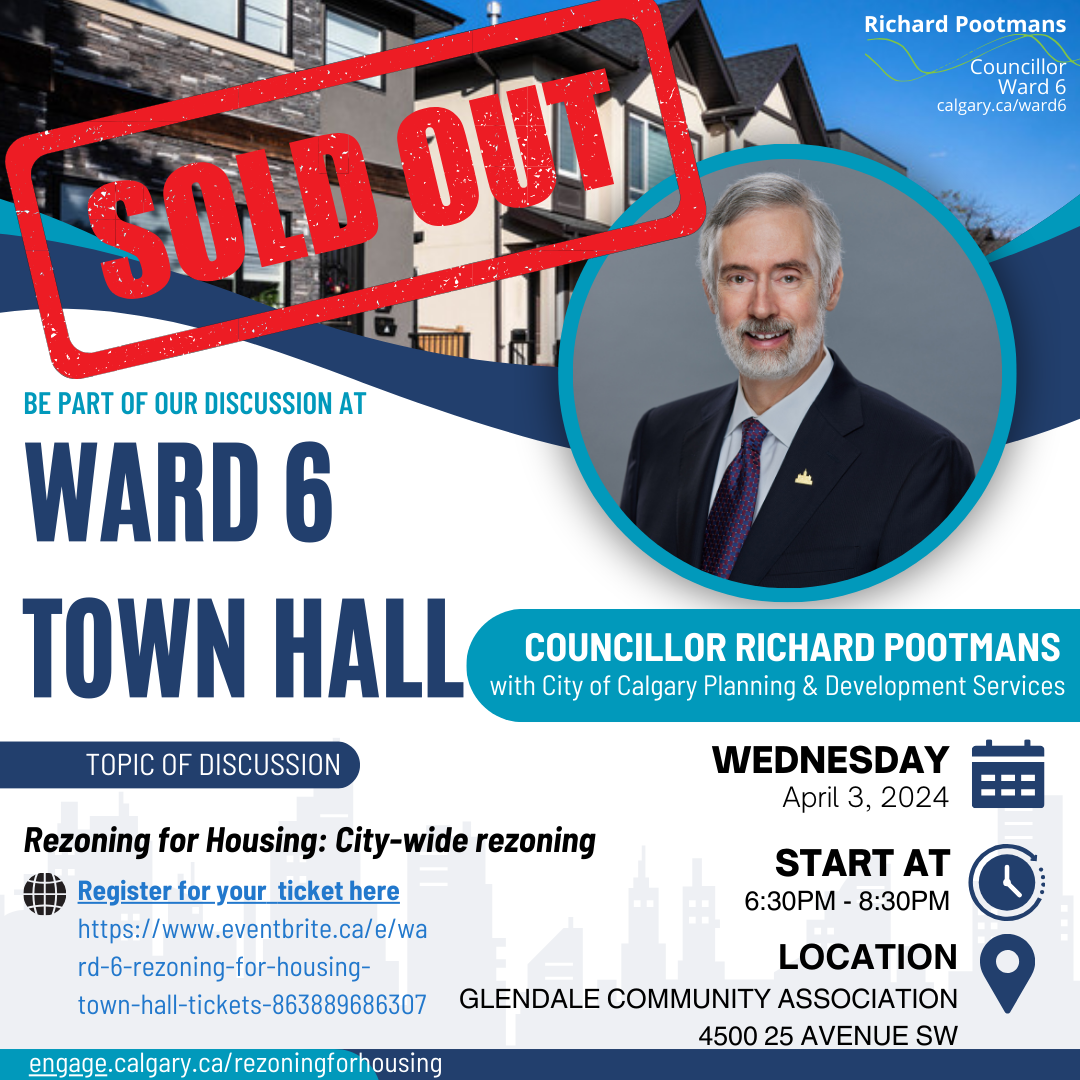
*The Rezoning for Housing Town Hall is currently sold out. If you have tickets and are not able to attend, please cancel your tickets via eventbrite. If you wish to be put on the waitlist follow this link
Councillor Richard Pootmans wants to hear from you regarding your thoughts about the city-wide rezoning for housing. This will be a Q & A session with City of Calgary Planning & Development Services team in attendance. Richard will be listening to public opinions in order to substantiate his position at the April 22 Public Hearing, where a final decision will be made.
Registration is mandatory due to room capacity. Sign up for registration here
Date: Wednesday, April 3, 2024
Time: 6:30 - 8:30 PM
Location: Glendale Community Association- 4500 25 Avenue SW
Can’t make it?
- Submit your thoughts to council here
Visit Rezoning for Housing | Engage (calgary.ca) for more information.
More Information and have your voice heard:
Visit calgary.ca/rezoningforhousing to learn more about what these changes could mean and whether your property will be affected. The page includes an interactive map to check the proposed zoning for your address.
Visit engage.calgary.ca to share your feedback with the City Administration team who will be making a recommendation to Council. The deadline to submit feedback to Administration is March 17.
You can also register to speak at Council's public hearing on April 22, or submit written feedback that will be published in Council's agenda and shared with all members of Council. Visit calgary.ca/publichearing to learn more.
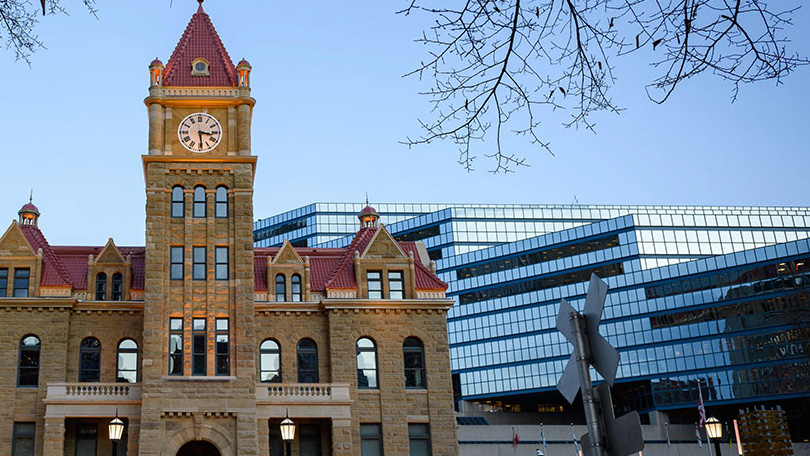
| Phone | ||
|---|---|---|
|
Booking Meetings Lori Gardner, Executive Assistant |
Email:
|
Phone:
403-268-1646 |
|
Community Concerns Ralph Smith, Community Assistant |
Email:
|
Phone:
403-268-1035 |
|
Communications Suzy Trottier, Communications & Community Liaison |
Email:
|
Phone:
403-268-1380 |
|
Email:
|
Phone:
|
Categories: Rezoning for housing, city wide rezoning

